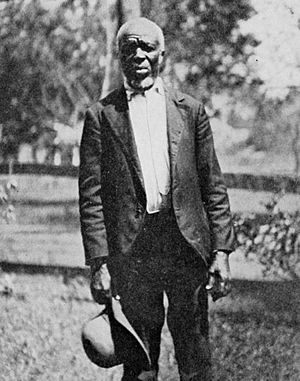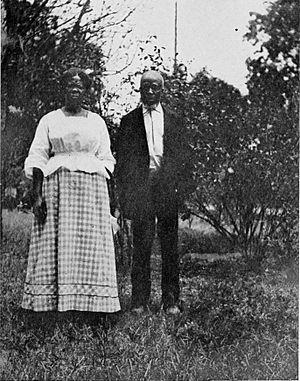Cudjoe Lewis facts for kids
Quick facts for kids
Cudjoe Lewis
|
|
|---|---|

Lewis c. 1914
|
|
| Born |
Oluale Kossola
c. 1841 Bantè, current-day Benin
|
| Died | July 17, 1935 (aged 94/95) |
| Occupation | Farmer, laborer, church sexton |
| Known for | survivor of the Atlantic slave trade between Africa and the United States |
Cudjoe Kazoola Lewis (born around 1841 – died July 17, 1935), whose birth name was Oluale Kossola, was one of the very last people to survive the Atlantic slave trade. This was when people were forcibly taken from Africa and brought to the United States.
In 1860, he and 115 other African captives were brought to the U.S. on a ship called the Clotilda. They landed secretly near Mobile, Alabama. The ship was then sunk on purpose to hide it from the authorities. The Clotilda remained hidden until January 2018.
After the American Civil War ended and slavery was abolished, Lewis and the others from the Clotilda became free. Many of them started a new community called Africatown near Mobile, Alabama. This community is now a special historic place.
As he grew older, Kossola shared his amazing story with visitors. He told them about his journey on the Clotilda and what happened to his group. He spoke with people like author Zora Neale Hurston. For a long time, people thought he was the very last survivor of the Clotilda. But later, historians found two other survivors who lived longer: Redoshi and Matilda McCrear.
Contents
Early Life and Capture
Cudjoe Lewis was born Kossola or Oluale Kossola around 1841 in West Africa. Americans later called him "Kazoola." He and most of the people in Africatown belonged to the Yoruba people from the Banté region of Benin. His parents were Oluwale and Fondlolu. He had many brothers and sisters.
In April or May of 1860, his village was attacked. Lewis was captured by female warriors led by King Glele of Dahomey. This happened during a yearly raid to capture people for the slave trade. Lewis and other captives were taken to a port called Ouidah. There, they were sold to Captain William Foster. He was the captain of the Clotilda, an American ship.
Bringing enslaved people into the U.S. had been against the law since 1808. But some people still illegally smuggled them in. The owner of the Clotilda, Timothy Meaher, was accused of breaking this law.
When the Clotilda arrived in the U.S. in July 1860, the government found out. Timothy Meaher and others were arrested. But the captives were quickly hidden. Without the people as evidence, the case was dropped.
Until the end of the Civil War (1861–1865), Lewis and his friends were forced to work for Meaher and his family. Lewis was bought by James Meaher. He worked as a deckhand on a steamboat. During this time, he became known as "Cudjo Lewis." He chose the name "Cudjo" because James Meaher had trouble saying "Kossola." "Cudjo" is a common name for boys born on a Monday in some African cultures.
Life in Africatown
Starting Africatown

While they were enslaved, Lewis and many other Clotilda captives lived in an area north of Mobile. It was called Magazine Point. This area was isolated, surrounded by a swamp and forest.
After slavery ended, the Clotilda captives tried to earn money to go back to Africa. The men worked in lumber mills. The women grew and sold food. But they could not save enough money to return home.
When they realized they couldn't go back, the group asked Lewis to speak with Timothy Meaher. They asked him for land. Meaher refused. So, the community kept saving money. They started buying land around Magazine Point. On September 30, 1872, Lewis bought about two acres of land for $100.
They built Africatown as their own special community. It was a place just for people of African descent. They chose leaders to follow their African traditions. They also built a church, a school, and a cemetery. Africatown was unique because it was a safe place from racism. It was also a home for people born in another country.
By 1914, the older founders of Africatown still preferred to speak their own language. But the residents also started to adopt American customs. Lewis became a Christian in 1869 and joined a Baptist church.
Family Life
In the mid-1860s, Lewis started a family with another Clotilda survivor named Abile. Her American name was "Celia." They officially married on March 15, 1880. They stayed together until Abile passed away in 1905.
They had six children: five sons and one daughter. They gave each child an African name and an American name. Their oldest son, Aleck, became a grocer. He lived with his wife in a house on his father's land. This was like a "family compound" in the Yoruba tradition. Another son, Cudjoe Feïchtan, died tragically in 1902. Lewis lived longer than his wife and all of his children.
Lewis worked as a farmer and laborer until 1902. That year, he was hurt in an accident with a train. After that, he couldn't do heavy work. The community then made him the sexton of their church. In 1903, the church became the Union Missionary Baptist Church.
Lewis became a naturalized American citizen on October 24, 1868. This was important because people born outside the U.S. did not automatically become citizens like former slaves born in America.
Storyteller and Historian
In the early 1900s, Lewis began sharing his story with writers and scholars. He told them about the history of the Clotilda Africans. He also shared traditional stories and tales. Emma Langdon Roche, a writer from Mobile, interviewed Lewis and other survivors for her 1914 book. She wrote about their capture in Africa, their time as enslaved people, and their lives in Africatown. They asked her to use their African names in her book. They hoped it might reach their homeland.
By 1925, Lewis was thought to be the last African survivor of the Clotilda. He was interviewed by Arthur Fauset, a folklorist. In 1927, Fauset published some of Lewis' animal tales. He also published Lewis' story about hunting in Africa.
In 1927, Zora Neale Hurston, a famous folklorist, interviewed Lewis. The next year, she published an article called "Cudjoe's Own Story of the Last African Slaver." In 1928, Hurston came back to interview him more. She took photos and recorded what is believed to be the only film footage of an African person who was brought to the U.S. through the slave trade. Based on these interviews, she wrote a book called Barracoon.
Hurston's book Barracoon: The Story of the Last "Black Cargo" was finally published in 2018.
Legacy
Cudjo Lewis passed away on July 17, 1935. He was buried at the Plateau Cemetery in Africatown. Because he was one of the last Clotilda survivors and his stories were written down, he became a very important figure in the community's history.
- In 1959, a special statue of Lewis was put in front of Africatown's Union Missionary Baptist Church. It was made by the Clotilda captives themselves.
- In 1977, an organization called the Association for the Study of African American Life and History honored Lewis and the Clotilda group.
- Around 1990, the City of Mobile put up a special marker for Lewis in the Plateau Cemetery.
- In 2010, archaeologists studied Lewis' old homesite in Africatown. They looked for items that showed African traditions in the daily lives of the founders.
- Barracoon: The Story of the Last "Black Cargo", Zora Neale Hurston's book about Lewis' life, was published for the first time in 2018.
See also
- List of slaves
- List of last survivors of American slavery
- Yoruba Americans



